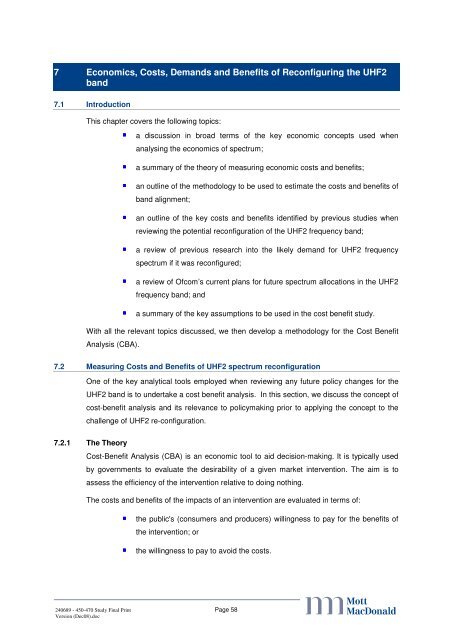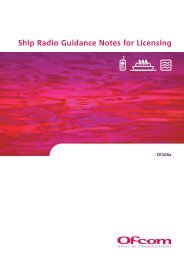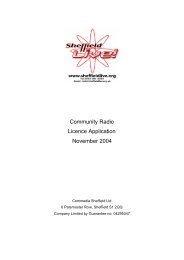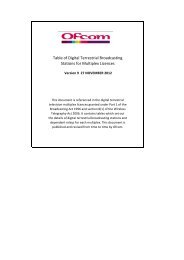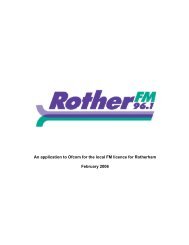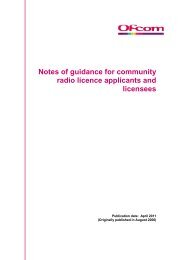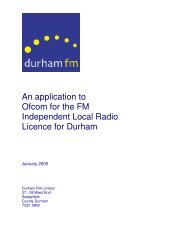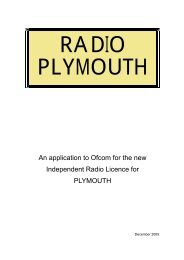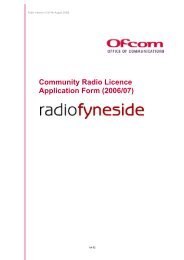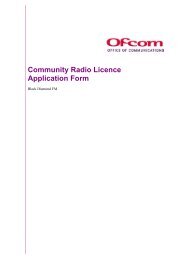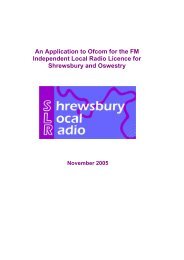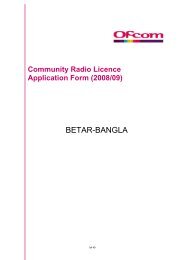UHF2 realignment study - Ofcom Licensing
UHF2 realignment study - Ofcom Licensing
UHF2 realignment study - Ofcom Licensing
Create successful ePaper yourself
Turn your PDF publications into a flip-book with our unique Google optimized e-Paper software.
7 Economics, Costs, Demands and Benefits of Reconfiguring the <strong>UHF2</strong><br />
band<br />
7.1 Introduction<br />
This chapter covers the following topics:<br />
240689 - 450-470 Study Final Print<br />
Version (Dec08).doc<br />
a discussion in broad terms of the key economic concepts used when<br />
analysing the economics of spectrum;<br />
a summary of the theory of measuring economic costs and benefits;<br />
an outline of the methodology to be used to estimate the costs and benefits of<br />
band alignment;<br />
an outline of the key costs and benefits identified by previous studies when<br />
reviewing the potential reconfiguration of the <strong>UHF2</strong> frequency band;<br />
a review of previous research into the likely demand for <strong>UHF2</strong> frequency<br />
spectrum if it was reconfigured;<br />
a review of <strong>Ofcom</strong>’s current plans for future spectrum allocations in the <strong>UHF2</strong><br />
frequency band; and<br />
a summary of the key assumptions to be used in the cost benefit <strong>study</strong>.<br />
With all the relevant topics discussed, we then develop a methodology for the Cost Benefit<br />
Analysis (CBA).<br />
7.2 Measuring Costs and Benefits of <strong>UHF2</strong> spectrum reconfiguration<br />
One of the key analytical tools employed when reviewing any future policy changes for the<br />
<strong>UHF2</strong> band is to undertake a cost benefit analysis. In this section, we discuss the concept of<br />
cost-benefit analysis and its relevance to policymaking prior to applying the concept to the<br />
challenge of <strong>UHF2</strong> re-configuration.<br />
7.2.1 The Theory<br />
Cost-Benefit Analysis (CBA) is an economic tool to aid decision-making. It is typically used<br />
by governments to evaluate the desirability of a given market intervention. The aim is to<br />
assess the efficiency of the intervention relative to doing nothing.<br />
The costs and benefits of the impacts of an intervention are evaluated in terms of:<br />
the public's (consumers and producers) willingness to pay for the benefits of<br />
the intervention; or<br />
the willingness to pay to avoid the costs.<br />
Page 58<br />
abc


